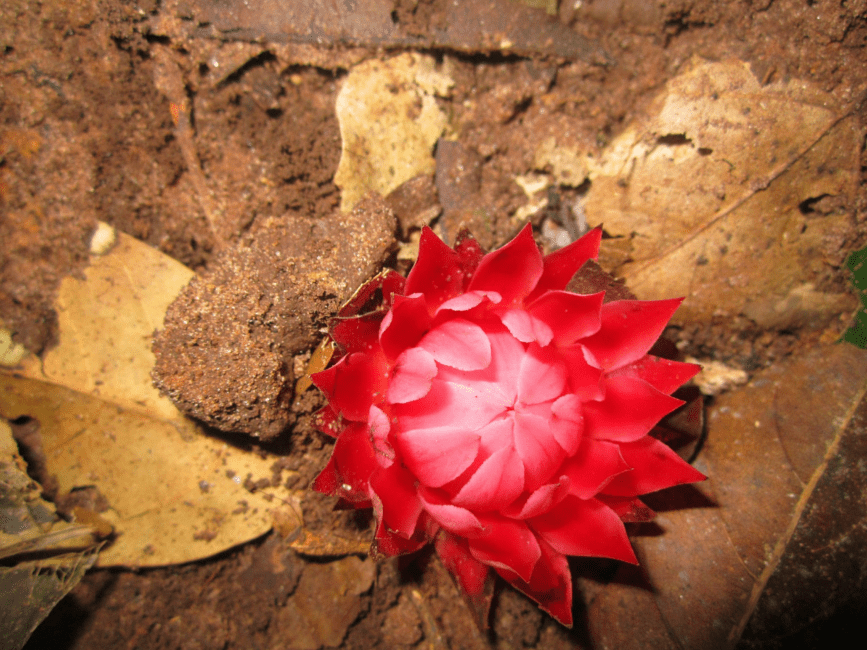Thonningia, scientifically known as Thonningia sanguinea, is a distinctive and intriguing plant that belongs to the Balanophoraceae family. Native to various tropical regions in Africa, this parasitic perennial herbaceous plant has earned the nickname African pipe due to its unique appearance resembling a tobacco pipe. Thonningia’s botanical features and growth habits make it a remarkable species within the plant kingdom.
Thonningia exhibits a fascinating structure that sets it apart from typical green plants. It lacks chlorophyll, the pigment responsible for photosynthesis, and consequently, it does not rely on sunlight for energy production. Instead, Thonningia is parasitic and obtains nutrients from host plants through its specialized root-like structures known as haustoria. These structures attach to the roots of the host plant, allowing Thonningia to tap into the host’s nutrient supply.
One of the most striking features of Thonningia is its vibrant and conspicuous inflorescence. The plant produces tall, erect flower spikes that can reach impressive heights. The inflorescence is composed of numerous small flowers densely arranged along the spike. The flowers are typically reddish in color, adding to the plant’s visual appeal.
Thonningia’s reproductive mechanism is unique and adapted to its parasitic lifestyle. The plant produces both male and female flowers, and the male flowers release pollen into the surrounding air. Wind plays a crucial role in transferring this pollen to the female flowers of neighboring Thonningia plants. Fertilization occurs within the female flowers, leading to the development of seeds.
Thonningia is primarily found in tropical regions of Africa, where it thrives in areas with suitable host plants. It often grows in the understory of dense forests or in shaded, humid environments that provide the necessary conditions for its parasitic lifestyle. The plant’s distribution spans regions with diverse climates and ecosystems, showcasing its adaptability to various conditions.
Thonningia holds cultural significance in some African communities, where it has been used for traditional medicinal purposes. Its striking appearance and unique growth habits have led to its inclusion in local folklore and traditional healing practices.
Due to its specialized habitat requirements and parasitic nature, Thonningia may face challenges in terms of habitat loss and host plant availability. Conservation efforts should take into account the plant’s unique ecological role and cultural importance.
Read Also: 11 Medicinal Health Benefits of Coptis Japonica (Japanese Goldthread)
The Medicinal Health Benefits of Thonningia (Thonningia sanguinea)

1. Immune System Boost: Thonningia contains bioactive compounds that have been associated with immune-stimulating properties. These compounds could help enhance the body’s natural defense mechanisms against infections and illnesses.
2. Anti-Inflammatory Effects: The plant’s extracts showcase anti-inflammatory potential, which could be valuable for managing inflammatory conditions such as arthritis and skin disorders.
3. Antioxidant Power: Thonningia is rich in antioxidants, substances that combat oxidative stress and protect cells from damage caused by free radicals.
4. Digestive Support: Traditionally, Thonningia has been used to alleviate digestive discomfort, including bloating and indigestion. It might contribute to better digestion by promoting a healthy gut environment.
5. Pain Relief: Some cultures employ Thonningia for pain management. Its potential analgesic properties could provide relief from mild discomfort.
6. Wound Healing: Thonningia’s extracts might possess wound-healing properties, potentially accelerating the recovery process of minor cuts and abrasions.
7. Respiratory Aid: Thonningia has historical use as a remedy for respiratory issues. It might offer relief from symptoms associated with coughs and bronchitis.
8. Cardiovascular Support: Initial studies suggest that Thonningia could positively impact heart health by promoting circulation and maintaining blood pressure levels.
9. Antimicrobial Activity: Thonningia’s antimicrobial properties could contribute to its traditional use in addressing infections.
10. Pregnancy and Postpartum Support: In certain African cultures, Thonningia is utilized to support women during pregnancy and postpartum periods. It is believed to provide strength and aid in postpartum recovery.
Read Also: 12 Medicinal Health Benefits of Cinnamomum Parthenoxylon (Yellow Camphorwood)
The Methods of Usage to Achieve the Provided Health Benefits of Thonningia (Thonningia sanguinea)
1. Infusions: Create a nourishing herbal infusion by steeping Thonningia leaves or stems in hot water. This infusion can be enjoyed as a soothing tea, allowing you to experience the potential health benefits of Thonningia.
2. Topical Application: Thonningia extracts or oils can be applied topically to wounds, inflamed areas, or sore muscles. This method aims to promote healing, reduce discomfort, and provide localized relief.
3. Tinctures: Prepare a concentrated Thonningia tincture by extracting its active constituents in alcohol or a suitable solvent. Adding a few drops of the tincture to water or juice can offer a convenient way to access its potential health-supporting properties.
4. Powdered Form: Dry Thonningia plant parts and grind them into a fine powder. This powdered form can be encapsulated for easy consumption or incorporated into smoothies and beverages for a holistic approach to wellness.
5. Traditional Preparations: In regions where Thonningia is part of traditional medicine, it might be combined with other herbs or ingredients to create specialized formulations for specific health concerns. Local healers often have a deep understanding of such combinations.
The Side Effects of Using Thonningia Medicinal Plant
1. Allergic Reactions: Individuals with sensitivities or allergies to Thonningia or related plants may experience allergic reactions upon exposure. If you notice any adverse symptoms such as skin rashes, itching, or swelling, discontinue use and seek medical attention.
2. Digestive Distress: Some people might experience digestive discomfort, such as upset stomach, nausea, or gastrointestinal disturbances, after using Thonningia. Starting with a small amount and gradually increasing the dosage may help assess your tolerance.
3. Interaction with Medications: Thonningia could potentially interact with certain medications. If you are taking prescription drugs or have underlying medical conditions, it’s crucial to consult a healthcare professional before using Thonningia to prevent any adverse interactions.
4. Pregnancy and Lactation: Pregnant and breastfeeding individuals should exercise caution when considering Thonningia. Limited research is available on its safety during these periods, so it’s advisable to consult a healthcare provider before use.
Read Also: How To Successfully Grow Sugarcane For High Yield And Profits
